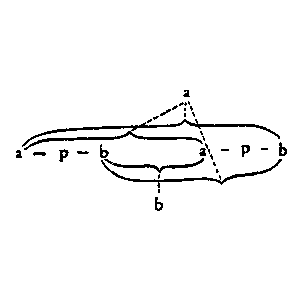| | Logical constants
can't be made into variables: because in them
what symbolises is not the same; ◇◇◇
ˇall symbols ◇◇◇ for wh.
a variable can be substituted symbolises in the
same way. We describe a symbol, & say This is a ˇarbitrarily ‘A symbol of this description is a tautology’. And then, it follows at once, both that any other symbol wh. answers to the same description is a tautology; & that any symbol which does not isn't. That is, we have arbitrarily fixed that that ˇany symbol of that description is to
Having thus fixed what is a tautology & what is not, we can then, having fixed arbitrarily again that if the relation the relation a – b is transitive ◇◇◇ get from the 2 facts together that e.g. ‘p ≡ ~(~p)’ ˇis a taut.. For ~(~p) = a – b – apb – a – b. It follows from the fact that a – b is transitive, that where we have a – b – a, the first a has to the second the same relation that it has to b. It is just as from the fact that a–true implies b–false, & b–false implies ctrue, we get that a–true implies c–true. And we shall be able to see, having fixed the meaning description of a tautology that, p ≡ ~(~p) is a tautology. That, when a
But now it is obvious that the a In settling that it is to be interpreted as a tautology & not as a contradiction, I am not assigning a meaning to a & b; i.e. saying that they symbolise different things but in the same way. What I am doing is to to say that the method way in wh. the a–pole is connected with the whole system symbol symbolises in a different way from that in which it would symbolise if the symbol were interpreted as a contradiction. And I add the scratches a & b merely in order to shew in which way the connection is symbolising, so that it may be evident that wherever the same scratch occurs in the corresponding place in another We could, of course, symbolise
Th connected in a certain way with an outside pole, in the other that they're not. The symbol for a tautology, whatever we take to in whatever form we find put it, e.g. whether by omitting the a–pole or by omitting the ub, would always be capable of being used as the symbol for a contradiction; only not in the same language. |
